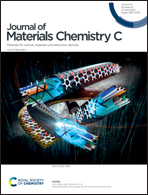Synaptic transistor with tunable synaptic behavior based on a thermo-denatured polar polymer material†
Abstract
Artificial synaptic transistors have shown great potential in artificial intelligence due to their low energy consumption, high scalability, similarity to biological neurons and precise regulation of channel conductance. A key step to achieving multifunctional synaptic transistors is to regulate synaptic weight in a fixed synaptic device using the same materials. However, the intrinsic properties of the films used for this purpose are affected by some uncertain factors, such as complicated processing and poor accuracy. Herein, a multifunctional synaptic transistor based on a thermo-denatured polar polymer material poly(2-acrylamido-2-methyl-1-propanesulfonic acid) (PAMPSA) is reported. Typical synaptic characteristics such as excitatory post synaptic current (EPSC), paired pulse facilitation (PPF) and long term potentiation (LTP) were successfully simulated under different annealing temperatures. More importantly, we have demonstrated that the polarization degree of PAMPSA was directly influenced by the annealing temperatures, and that even small temperature changes (<20 °C) would allow a wide regulation range of synaptic weight, indicating that the synaptic weight can be modulated purposefully and precisely. Hence, this work provides a simple, convenient and accurate approach to regulate synaptic weight and the memory retention of an artificial synapse via modulation of the annealing temperature, which facilitates a wide simulation range of artificial synapses and the development of artificial neuromorphic devices.



 Please wait while we load your content...
Please wait while we load your content...